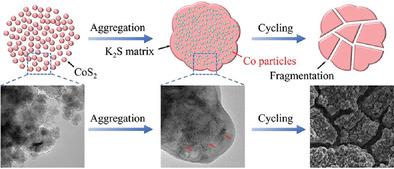当前位置:
X-MOL 学术
›
Adv. Energy Mater.
›
论文详情
Our official English website, www.x-mol.net, welcomes your
feedback! (Note: you will need to create a separate account there.)
Anti-Aggregation of Nanosized CoS2 for Stable K-Ion Storage: Insights into Aggregation-Induced Electrode Failures
Advanced Energy Materials ( IF 24.4 ) Pub Date : 2022-06-07 , DOI: 10.1002/aenm.202201259 Hehe Zhang 1 , Yong Cheng 1 , Jingjie Sun 1 , Weibin Ye 1 , Chengzhi Ke 1 , Mengting Cai 1 , Haowen Gao 1 , Ping Wei 1 , Qiaobao Zhang 1 , Ming‐Sheng Wang 1
Advanced Energy Materials ( IF 24.4 ) Pub Date : 2022-06-07 , DOI: 10.1002/aenm.202201259 Hehe Zhang 1 , Yong Cheng 1 , Jingjie Sun 1 , Weibin Ye 1 , Chengzhi Ke 1 , Mengting Cai 1 , Haowen Gao 1 , Ping Wei 1 , Qiaobao Zhang 1 , Ming‐Sheng Wang 1
Affiliation

|
As promising conversion-type anode materials for potassium-ion storage, transition metal chalcogenides (TMCs) exhibit high energy density but suffer severe capacity fading, which is generally ascribed to their large volume expansion and the associated structural degradation. Instead, this study emphasizes that the aggregation of nanosized TMCs during conversion reaction is a more crucial reason for the following serious electrode failures. This issue has not received enough attention, and especially the detailed aggregation mechanism and its relationship to electrode failures remains unclear. Thus, by combining in situ and ex-situ electron microscopies, the aggregation evolution of nanosized CoS2 is systematically investigated from micro to macro scale. The aggregation originates from the coalescence of the K2S matrix during potassiation, which constantly develops into larger-scale agglomerates as the cycling continues, eventually leading to electrode fragmentation, etc. To address this issue, an anti-aggregation strategy is proposed through isolating CoS2 nanoparticles inside individual carbon nanoshells. Impressively, the CoS2 aggregation is strictly confined within each nanoshell, which prevents their extensive aggregation across the electrode, resulting in the superior structural and electrochemical stability. This work reveals the mechanism of aggregation-induced electrode failures and proposes the necessity of anti-aggregation of nanosized active materials for the design of high-capacity electrodes.
中文翻译:

用于稳定 K 离子存储的纳米 CoS2 的抗聚集:对聚集引起的电极故障的见解
作为有前景的用于钾离子存储的转换型负极材料,过渡金属硫属化物(TMCs)具有高能量密度,但容量衰减严重,这通常归因于它们的大体积膨胀和相关的结构退化。相反,本研究强调纳米级 TMC 在转化反应过程中的聚集是导致以下严重电极故障的更关键原因。这个问题没有得到足够的重视,尤其是详细的聚集机制及其与电极故障的关系仍不清楚。因此,通过结合原位和非原位电子显微镜,从微观到宏观尺度系统地研究了纳米CoS 2的聚集演化。聚集源于 K 的聚结2 S 基体在钾化过程中,随着循环的继续不断发展成更大规模的团块,最终导致电极碎裂等。为了解决这个问题,提出了一种通过将 CoS 2纳米颗粒隔离在单个碳纳米壳内的抗聚集策略。令人印象深刻的是,CoS 2聚集被严格限制在每个纳米壳内,这防止了它们在电极上的广泛聚集,从而获得了优异的结构和电化学稳定性。这项工作揭示了聚集诱导电极失效的机制,并提出了纳米级活性材料抗聚集对于设计高容量电极的必要性。
更新日期:2022-06-07
中文翻译:

用于稳定 K 离子存储的纳米 CoS2 的抗聚集:对聚集引起的电极故障的见解
作为有前景的用于钾离子存储的转换型负极材料,过渡金属硫属化物(TMCs)具有高能量密度,但容量衰减严重,这通常归因于它们的大体积膨胀和相关的结构退化。相反,本研究强调纳米级 TMC 在转化反应过程中的聚集是导致以下严重电极故障的更关键原因。这个问题没有得到足够的重视,尤其是详细的聚集机制及其与电极故障的关系仍不清楚。因此,通过结合原位和非原位电子显微镜,从微观到宏观尺度系统地研究了纳米CoS 2的聚集演化。聚集源于 K 的聚结2 S 基体在钾化过程中,随着循环的继续不断发展成更大规模的团块,最终导致电极碎裂等。为了解决这个问题,提出了一种通过将 CoS 2纳米颗粒隔离在单个碳纳米壳内的抗聚集策略。令人印象深刻的是,CoS 2聚集被严格限制在每个纳米壳内,这防止了它们在电极上的广泛聚集,从而获得了优异的结构和电化学稳定性。这项工作揭示了聚集诱导电极失效的机制,并提出了纳米级活性材料抗聚集对于设计高容量电极的必要性。











































 京公网安备 11010802027423号
京公网安备 11010802027423号